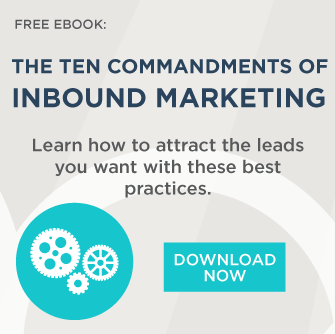The Ultimate Checklist for Inbound Marketing Success
What makes for successful inbound marketing? Easy, results. How do you get results in the form of ROI? Creating and implementing strategies...


Inbound marketing has become a cornerstone for businesses in every corner of every industry, from B2B to B2C. Any good marketer will know this methodology requires a thought-out implementation plan with long-term objectives. But, even the most seasoned marketers can develop decision paralysis when developing an inbound marketing strategy.
To combat that deer-in-the-headlight feeling you might be having, use this baseline guide when planning out your short-term and long-term inbound marketing strategy.
 Like any good business plan, your inbound marketing strategy should be developed with the broader goal in mind. In fact, it’s best to develop a S.M.A.R.T. goal on which to build your implementation framework.
Like any good business plan, your inbound marketing strategy should be developed with the broader goal in mind. In fact, it’s best to develop a S.M.A.R.T. goal on which to build your implementation framework.
This goal could include multiple different metrics, depending on the size, growth, and capacity your organization has. It could include getting 50 sales qualified leads from your inbound marketing channels in a single year, $150,000 in sales that were directly sourced from inbound for the year, a 5% increase in revenue from the previous fiscal year, or infinitely many other options. The key thing to remember is that your goal needs to be specific, measurable, attainable, relevant, and time-bound.
In fact, it also makes sense to parse your broader goal into a set of subgoals your team can aim for on a quarterly or yearly basis.
Achieving $150,000 in closed sales from inbound might seem intimidating if you have a small sales team and are just getting started with your inbound strategy, but focusing on closing $37,500 per quarter—or adjusting for your busy and slow seasons—makes that end goal feel more achievable.
Nothing can kill a good inbound marketing strategy quite like saddling one person with all of the responsibilities involved. Inbound marketing can take multiple hours per week and requires some knowledge to execute effectively. This is why many organizations decide to hire an outside agency to help with their inbound marketing efforts because it's more cost-effective, efficient, and produces better results.
If you give inbound marketing duties to someone who’s already got a full plate, they’ll either delegate or let the tasks relating to inbound fall to the wayside in favor of keeping up with their current workload. After that, it’s somewhat inevitable that your inbound marketing strategy won’t keep up with the goals you set—or worse, fall to the wayside altogether.
The easiest way to prevent this setback is to divide different responsibilities around your inbound marketing strategy to multiple different people.
For example, you might have your director of marketing or another employee who’s intimately familiar with your brand in charge of approvals for inbound-related content and overseeing the rollout of the strategy as a whole. However, the day-to-day tasks for developing the content and the plans for optimizing that content might fall to another person passionate about writing and SEO. Then, for any more technical details, you might choose to have a third person handle uploading the content to your website, making any adjustments in the HTML code, and publishing your social media posts in optimized ways to drive traffic.
While your setup might not exactly fit that description, delegating responsibilities between different employees will prevent bottlenecks during any part of the implementation process and make the rollout for your inbound marketing strategy run more smoothly.
Just like how humans can’t live solely on a diet of corn chips, your inbound marketing plan can’t consist only of blogging, especially if you want to start seeing results sooner instead of later.
Instead, supplement your blogging tactics with a few other content options that will strengthen your inbound marketing strategy:
Regular website maintenance
Search engine optimization
Targeted email marketing
Forms on every webpage
Links back to your website on social media
Smart or A/B-tested website content
Video content
Gated content behind forms designed for lead capture
Those are just a few examples. Inbound marketing has countless options for attracting and converting leads into customers, but the best way to get them to that next step is by having a variety of ways to engage with your brand’s content on their own terms.
What would be valuable enough for you to give somebody your email address to get it?
This is a question you should always ask yourself when developing content to support your inbound marketing strategy. While the preferences might vary between each of your different target personas, the offers you give them should be worth trading their personal information.
It’s also smart to provide various types of gated content. Your webinars might have your industry’s version of the 11 herbs and spices, but if you put out 10 other webinars before publishing that one, your leads might ignore them altogether. After all, fatigue sets in quickly, and they might prefer to learn about their industry through different media than spending 30 minutes listening to your webinar—or 15 minutes jumping back and forth in the playback while they look for your different key points.
Instead, consider providing value to your inbound marketing contacts with variety. Depending on the preferences of your target personas, this might include:
Infographics
Short-form video content
Interactive eBooks or worksheets
Whitepapers
Digital industry-themed templates
Pillar pages
One-sheets
Case studies
Live events
Podcasts
This isn’t an exhaustive list. The landscape of content people are willing to download is ever-changing and varies greatly depending on the industry. Your best bets are to determine what works for your organization by trial and error and by asking your existing customers directly how they like to learn new information about their industry.
As the old saying goes, Rome wasn’t built in a day. However, the frequently forgotten second part of the phrase is, “But they were laying bricks every hour.”
Like any sustainable marketing or sales strategy, inbound marketing is not some cure-all that will instantly triple the number of leads coming to your website. It takes time and effort to get fully up and running in a way that directly yields to sales. It won’t happen overnight, and it might take time to make a breakthrough with those keywords you’ve been targeting for your industry or for your first customer to come through Google search. Once it starts, though, it’s less likely to stop if you keep contributing to the strategy.
You might understand that, but make sure your stakeholders are also aware of the expectations involved with planting seeds in the garden of long-term results.
Developing an inbound marketing strategy for your organization will help it stay sustainable for the long term. This is because it’s compatible with how consumers follow their path to purchase. However, be prepared to commit to it for the long term and expect long-term benefits—with the appropriate goals in mind; it will help you grow sustainably and continue to attract and retain customers.

What makes for successful inbound marketing? Easy, results. How do you get results in the form of ROI? Creating and implementing strategies...

Inbound marketing has become a buzzword in the digital realm, promising to revolutionize the way businesses attract and engage customers. However,...

Optimizing your inbound marketing performance starts with measuring the key metrics that show you if your strategy is effective or if it’s time to...